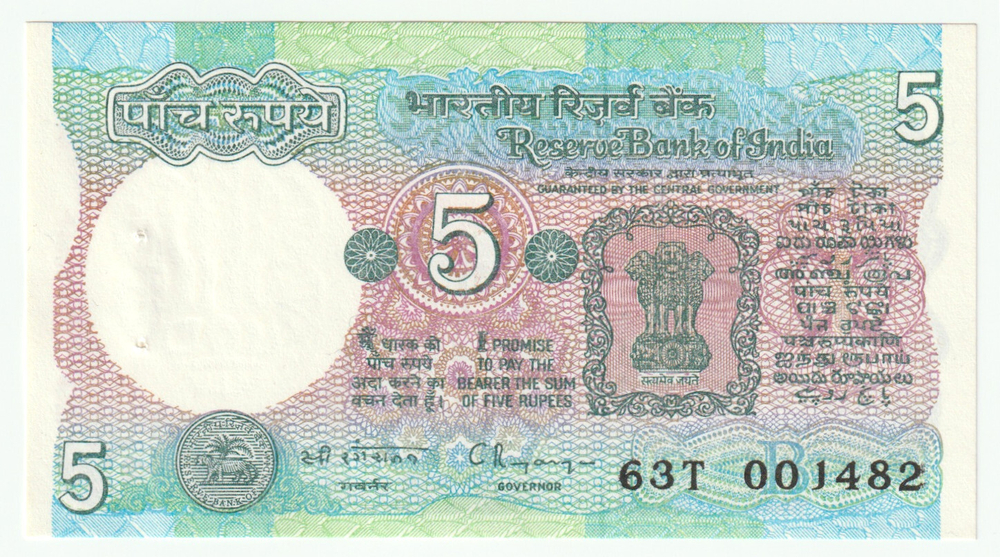Characteristics
This issue from 1997 belongs to the standard circulation banknote category..
This piece could appeal to those assembling thematic collections by country, historical period, or notable individuals. Its characteristics accurately reflect the period and underline its historical importance.
The price for this item is 0.59 €, reflecting its condition, historical rarity, and characteristics. This makes it suitable both for personal collections and as an investment asset.
India, 5 Rupees, 1997 (AU) is a perfect choice for collectors seeking historically significant items with proven provenance.
After receiving your order, you may return it in whole or in part within 15 days of delivery if you are not satisfied for any reason.
All shipments are made via Registered/Insured mail through Poste Cyprus within two working days of receiving payment. Customers will receive an email notification with a tracking code to monitor the shipment in real-time.
Shipping Costs for Cyprus:
- Orders up to 1 kg: €8.00
- Orders more than 1 kg up to 2 kg: €15.00
- Orders more than 2 kg up to 3 kg: €20.00
- Orders more than 3 kg up to 15 kg: €30.00
International Shipping Rates:
- Orders up to 200 g: €10.00
- Orders more than 200 g up to 1 kg: €15.00
- Orders more than 1 kg up to 2 kg: €25.00
- Orders more than 2 kg up to 3 kg: €30.00
- Orders more than 3 kg up to 15 kg: €70.00
Delivery Times:
- Domestic Delivery (Cyprus): Orders are typically delivered within 3 - 5 working days.
- International Delivery: Orders are delivered within 5 - 14 working days from the conclusion of the contract (or from the date of payment instruction in case of advance payment).
Please note that deliveries are not made on Sundays or public holidays.
If you have ordered items with different delivery dates, all items will be sent together in one shipment unless another arrangement has been made. The delivery date for the complete order will match the item with the longest delivery time.
Self-Collection:
If you choose self-collection, we will notify you via email when the product is ready, along with the collection options. In this case, no shipping costs will be charged.
Full Insurance:
VERcity ensures complete responsibility for all shipments. In the rare event of loss or theft, after verification with Poste Cyprus, we guarantee a full refund to the customer.
At VERcity, we provide multiple secure payment options to ensure a seamless and safe shopping experience. The available payment methods may vary depending on your country of residence:
PayPal
If you have a PayPal account, you can pay quickly and securely without needing to enter your credit card details for each purchase. PayPal ensures that your financial information remains private and is not shared with the recipient, offering you a completely secure payment experience.
Credit Card
We accept payments with the following cards: Mastercard, Visa, Eurocard, and Visa Electron. All transactions are securely processed through our trusted payment gateway, ensuring your payment is safe, reliable, and free of any additional charges.
Bank Transfer
After confirming your order, you will receive an email containing all the necessary information to complete your payment via bank transfer. This option is perfect for those who prefer direct bank payments.
Note: The availability of specific payment methods may vary depending on your country. Please select your preferred option during the checkout process for a smooth and secure experience.
If you have any questions, please feel free to contact us at info@vercity.net. We're happy to assist you!
This 5 Rupee banknote from 1997 is a vivid representation of India's commitment to its agricultural roots and economic development. It features timeless designs that resonate with both collectors and historians.
Key Features:
-
Distinctive Design: The banknote is characterized by a practical yet striking design, utilizing traditional color schemes and patterns to highlight its value.
-
Agricultural Theme: The reverse depicts a farmer tilling the field with a tractor, a scene that captures the essence of India's rural economy and the importance of agriculture to the nation.
-
Government Assurance: The obverse includes a guarantee by the Central Government and a promise to pay the bearer five rupees, emphasizing the note's reliability and legal backing.
-
Symbolic Watermark: Features the Lion Capital of Ashoka as its watermark, symbolizing India’s rich heritage and the ideals of peace and unity that Ashoka promoted.
Collector’s Insight: The 1997 edition of the 5 Rupee note offers a glimpse into the socio-economic emphasis of India during the late 20th century. It is a must-have for those interested in the progression of India's currency design and its reflection of national priorities. This note, with its deep cultural references and historical significance, is particularly appealing to those who collect pieces that illustrate the narrative of a nation's development.












